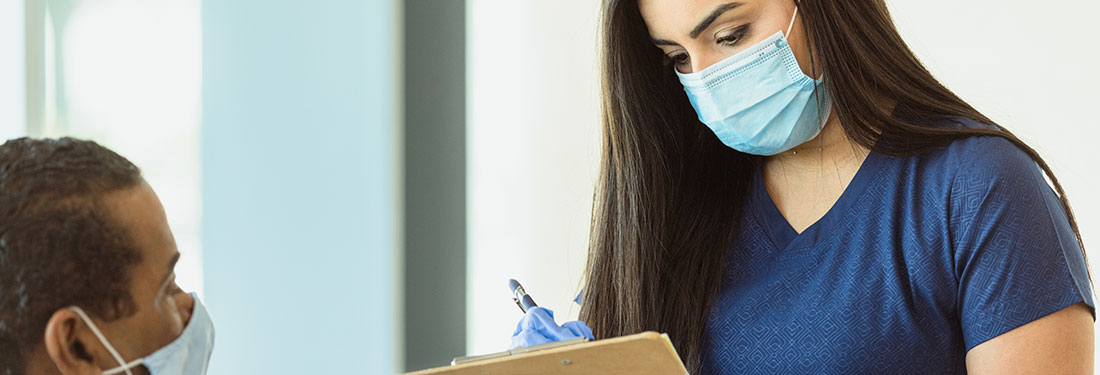How a Team Took on a Small Space to Improve Care for Respiratory Patients
Everyone knows that lean tools and methods are great for improving health care processes. But many don’t know that culture is key to making innovative changes that take the work to the next level. Our clients at The Shrewsbury and Telford Hospital NHS Trust, in Shropshire, England, are a testament to what can happen when health care leaders and staff collaborate in new ways to put the patient first and end up exceeding their own expectations for patient care.
Understanding the respiratory patient’s experience
The improvement team in this Shropshire ambulatory care clinic, made up of leaders, physicians, nurses and assistants, knew that their patients waited too long to get care — and they wanted to learn how to diagnose and treat their patients much more quickly. As they began their improvement work, the sponsor met with the team to communicate a sense of urgency, challenging them to see the experience from the patient’s point of view and encouraging them to be innovative and collaborative as they worked to achieve just-in-time patient care.
In a passionate delivery, she described their patients with COPD and asthma as neighbors who were seeking the right care for their difficulty with breathing. Every passing minute they waited was another minute the patients were gasping for air.
What observing the current state revealed
Through observation, the team members discovered several things about their patients’ experiences and their staff members’ experiences.
First, they saw that the waiting room was very small and crowded, and they experienced a feeling of chaos. Many patients who came in the door were frail, and some had been delivered by ambulance on gurneys in the already crowded space, where they might wait hours to be seen. Desperate to take care of the patients in a dearth of space, nurses assessed essentially all patients in an open area, where anyone in the crowded waiting room could witness the exams.
The team also observed that the reception desk was a centralized location between the waiting room and the exam rooms. At this enormous L-shaped desk, the team members observed many wastes, including the wastes of inventory and motion. File cabinets underneath the desk created an uncomfortable workspace for the ward clerks. With unnecessary papers and equipment cluttering the area, the ward clerks had been forced to place the photocopier, which they used multiple times in a day, in the waiting room with patients and families.
Finally, the team recognized how often nurses and physicians were forced to leave the exam room in the middle of an assessment because the room was missing equipment or supplies necessary to do their job. Inevitably, their time would be spent “searching for the missing items in a frantic manner” or being interrupted by another staff member looking for the missing equipment. Using lean tools to gather their observations of waste and defects, they began to challenge each other’s thinking of “the way things were done.” They asked: How can we optimize our space for better patient care to be delivered in a thoughtful manner by our colleagues? How can we give our patients the privacy and dignity they deserve? How can we have the equipment we need, in the right place and at the right time? To get started, they generated ideas.
“Early on, the team expressed how stressful it was to be searching for equipment all day, how the situation seemed hopeless at times, and how they felt they couldn’t do anything about it. They said that in fact, this frustrating work environment had become the norm for them. All they wanted to do was take care of their patients as well as they could and as quickly as possible, and they did their best every day. The use of lean methods highlighted so many of the wastes surrounding their environment — some they were aware of, some they weren’t — and that was a hard message to swallow.”
– Melissa Lin
Does this desk have to be so big?
Their idea brainstorming began with a recognition that their clinical space was small and limited, but the workshop leaders encouraged them to think outside the box.
One team member, when considering the large L-shaped desk that was such a barrier to patient and staff flow, asked, “What if we cut the desk in half?” People laughed, but the provocation made them curious. When the team went back to the clinic, one team member got down on the floor to check out the desk and realized that the desk could be separated naturally with a simple hex key. In no time the desk was split in half, and the team pushed one half out of the clinic. What started as a funny idea became a reality and the cleared area gave the team more space to be innovative. They utilized the lean principles of 5S (sort, simplify, sweep, standardize and self-discipline) to reduce equipment and files down to the necessary items and rearranged the furniture (including the photocopier from the waiting room) so that they were at point-of-use for the ward clerk. By the end of the day, the clerk was checking in patients more efficiently, without having to walk across the hall to the copier to retrieve documents.
When the rest of the team saw the rearrangements, it was a big moment. The space that they thought they had to live with, with furniture they thought could not be changed, had suddenly been transformed into something so much better — and it was because the team members were given the time and permission to see everything differently and to solve this problem of chaos and inefficiency on their own.
Does this closet need to be a closet?
Spurred by the reception-area improvement, they began to question the use of other traditionally held spaces. One team member, a senior nurse, had been brought in from another part of the organization to contribute an outside perspective. During her genba walk around the ambulatory care unit, she observed aloud that there seemed to be a lot of supplies — three supply closets crammed full — for such a small clinical unit.
The team used the lean principles of 5S again to organize each closet and discovered supplies they never used, such as welcome kits for inpatient admissions in a walk-in clinic and large syringes delivering doses that were rarely used in this unit. Within hours, they were able to organize and label things so well that all the supplies they needed fit into two closets.
The senior nurse then looked at the empty closet. “I’d be curious,” she said, “if we could make this into a triage room.” They analyzed the closet space to find out that it was actually a small room that had been converted into a closet. In no time the team was removing shelves and pulling in a small table, chair, an observation machine, a portable supply kit and privacy curtain. Now their patients who arrived gasping for breath were no longer seen in the open waiting room. Instead, they were quickly led to this new triage room, where the staff could immediately use the observation machine — now in its permanent place — to evaluate the patient. And the privacy curtain protected the patient’s dignity during this stressful time.
How does the culture fit in?
Early on, the team expressed how stressful it was to be searching for equipment all day, how the situation seemed hopeless at times, and how they felt they couldn’t do anything about it. They said that in fact, this frustrating work environment had become the norm for them. All they wanted to do was take care of their patients as well as they could and as quickly as possible, and they did their best every day. The use of lean methods highlighted so many of the wastes surrounding their environment — some they were aware of, some they weren’t — and that was a hard message to swallow.
But the use of lean methods also empowered the team to make a difference. Keeping the patients first, they created ideas to really tackle the problems they encountered every day. The team members were committed and disciplined about their work — and they cared. They saw the inherent waste in their processes, and they saw how that affected their patients, who were sick and waiting for such a long time for clinical care.
For some people outside the team, the changes were unsettling. The old culture was so embedded that it was difficult for some to see how the changes could improve their work and the care they provided to patients. But the team members had faith in their work and talked through the changes with their colleagues. “We’re trying to make things easier on our patients,” they said, “and reduce the frustration for us.”
The leaders were thrilled with the results, and they celebrated the excellent work that the team accomplished in a single week. The team members and their coworkers loved the new spaces and redesigned processes they’d created and later implemented themselves. They also loved knowing that the equipment they needed to do their work was in the right place just when they needed to use it. And best of all, they could see firsthand that their patients were being treated more quickly and with more dignity every day.
All of this was possible because the leaders had trusted the process and their staff to make significant changes to improve care. This new culture of trust, encouragement, empowerment and respect — with the patient always at the top of their minds, in every minute of their improvement work — provided the groundwork necessary to help an ambulatory care clinic more quickly and respectfully diagnose respiratory patients who were struggling to breathe as they came through the door.
Learn more about this team’s first Rapid Process Improvement Workshop (RPIW) for respiratory patients.
Related Services
Custom Seminar
Our customized learning experience not only details Virginia Mason’s history of successfully applying its patient-centered lean tools and methods to health care, but also addresses the participating organization’s specific challenges and opportunities.
Executive Retreat
Our executive learning experience explores lean methods, the connection between systemwide respect and safety, and the essential leadership qualities necessary for transformation: transparency, visibility and a sense of urgency.
Improving Flow in the Ambulatory Setting
Teams consisting of health care providers, leaders, and clinical team members are empowered to improve flow by learning to reduce wait times, increase quality, and remove non-value-added activities from their day. Through the development of effective standard practices participants learn to foster a high-functioning team environment, improve economic performance, and ultimately, improve both patient and staff satisfaction.
Foundations of Process Improvement in Healthcare
Learn the foundations of lean, key terminology, essential concepts and the tools to implement them in your health care organization to produce value-creating processes and eliminate waste — all in pursuit of the perfect patient experience.






